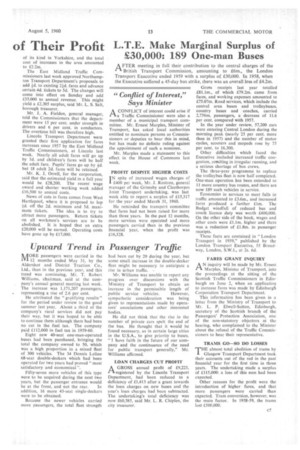£30 000 189 0 man B ses
Page 43

If you've noticed an error in this article please click here to report it so we can fix it.
, ne
A FTER meeting in full their contribution to the central charges of the 4-1. British Transport Commission, amounting to £6m., the London Transport Executive ended 1959 with a surplus of £30,000. In 1958, when the Executive suffered a 45-day bus strike, there was an overall loss of £4.2m.
Gross receipts last year totalled £81.1m., of which £79.2m. came from fares, and working expenses amounted to £75.07m. Road services, which include the central area buses and trolleybuses. country buses and coaches, carried 2,756m. passengers, a decrease of 11.6 per cent, compared with 1957.
In the year under review, 57,200 cars were entering Central London during the morning peak (nearly 25 per cent. more than in 1957) and the number of motor cycles, scooters and mopeds rose by 75 per cent. to 16,300.
Other difficulties which faced the Executive included increased traffic congestion, resulting in irregular running, and a serious shortage of bus crews.
The three-year programme to replace the trolleybus fleet is now half completed. One-man operation has been extended to 11 more country bus routes, and there are now 189 such vehicles in service.
Economies in services to meet falls in traffic amounted to £3.6m., and increased fares produced a further £1m. The Budget windfall of reduced bus and coach licence duty was worth £400,000. On the other side of the book, wages and other costs were flint, higher and there was a reduction of £1.8m. in passenger receipts.
These facts are contained in "London Transport in 1959," published by the London Transport Executive, 55 Broadway, London. S.W.1., at 2s. 6d.




































































































